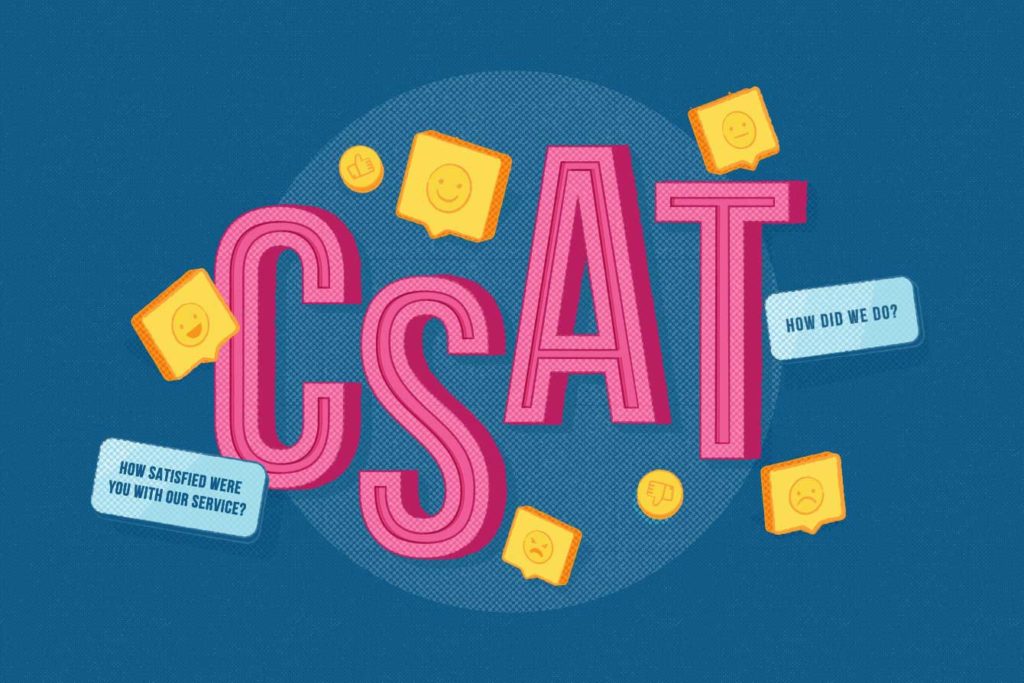CSAT surveys serve as a guidepost for a customer’s journey with your product or brand. You’re going to need that guidepost if you want to create a strategy that’ll ultimately bring the customer greater satisfaction.
But your survey is only as good as the way it’s crafted. Writing good questions is a great start, but there are other factors to consider for the most effective surveys—like rating system, the length of the survey, and how well you empathize with the customer’s experience.
Let’s start with tips on how to write effective survey questions (including language, the rating scale, demographics ), when to send the surveys, sample questions, and why you shouldn’t rely on one metric alone.
Create effective surveys that get results.
Surveys are critical to a company’s health. A well-crafted survey will yield actionable responses that can help you strategize for long-term growth. It can help you identify pain points in the customer journey, work on resolving those issues, or let you know which business unit is flourishing and which is struggling so that you can allocate resources accordingly.
That’s what a well-crafted survey can do. A poorly crafted survey will inevitably lead to non-responses (in the form of unopened or unanswered emails) or, in worst-case scenarios, annoy your customers.
Crafting questions correctly is the first step.
Grammatical errors, typos, and bad sentence structuring will stop a respondent dead in their tracks. If your customer feels you don’t care enough to proofread your work, why should they bother answering your questions? Make sure to have a second (or even third) set of eyes to look over your questions.
Also, it doesn’t hurt to follow these guidelines:
- Keep your questions short. Long, verbose questions and difficult-to-understand answers are major reasons respondents fail to complete surveys. It’s also a good idea to avoid jargon.
- Target the right demographic. Using customer feedback and profiles of your customer base, ask questions that focus on the audience you serve. If you’re customers fall in a specific gender or age demographic, target questions that would be in line with them
- Focus your questions on a specific topic. Make sure your questions follow a logic throughout the survey. If you want to know how the customer feels about the product, focus on the product with CSAT (customer satisfaction) questions. If you want to know about your company’s standing in the customer’s eyes, then use NPS (Net Promoter Score) questions.
Prioritize your objectives.
Make sure you’re laser-focused on your objectives before crafting any survey.
Are you trying to find pain points in customer service? Send out a CSAT. Do you want to know what your customers think of your company or brand’s reputation? Send out an NPS. Do you know the website or checkout process is causing problems but don’t know where to focus? Send out a CES survey. Your objective will determine the type of survey you send.
Granted, even within a CSAT surveys, you need to prioritize which topics are most important and put those at the top. You could ask about their satisfaction with the product, their support experience, their experience setting up the product—all within the same survey. Setting priorities of which questions are most important will help you make the survey the most actionable—and completable.
Empathize with your customer’s journey to get more effective results.
One of the best ways to craft a survey is to put yourself in the customer’s shoes. To craft a top-notch survey, be the customer. Imagine what they’re seeing and how they’re feeling about the questions being asked. Use the customer’s profile to craft your questions. Are you in the same demographic as your customer? Imagine them as your friends or family members — would the questions make sense to your circle?
Empathizing with the customer is important—that understanding can go a long way in predicting their pain points. Take Mary from Duluth, an older woman, kids going to college, divorced. She calls to complain about the difficulty of using the website, the expense of buying your products, and that customer service hasn’t been helpful. Consider Mary’s journey and ask yourself: Does she have the time or patience to answer survey questions? Should we survey about a product her college-bound children might benefit from? What happened with customer service? Was the conversation just a “blip,” or is there an underlying issue we should be addressing in the survey? Before you send out a survey, really try to understand the customer base so you can ask focused questions that make sense to your customer.
Identify the rating scale you’ll use.
Rating scales are important to know before crafting your surveys because they’ll determine how you ask your questions. There are dozens of rating scales you can use in surveys, like Guttman scales, semantic differential scales, and forced-choice, or ipsative scales. Below are examples of a few of the most common rating scales used and a brief explanation of what they accomplish and why you should use them.
A basic numerical scale
Offer a simple scale of finite numbers which the customer can use to respond to your question. Normally, lower numbers represent positive answers, while higher numbers represent negative answers.
Numerical Rating Scale
| 1 Very satisfied |
2 | 3 | 4 | 5 Not satisfied |
|
| Example customer satisfaction survey based on a numerical rating scale. | |||||
| How did you like our product or service? | ☐ | ☐ | ☐ | ☐ | ☐ |
| Were you satisfied with our customer service? | ☐ | ☐ | ☐ | ☐ | ☐ |
Pro: The numerical score rating is best when you want simple numerical data and straightforward answers.
Challenge: Leaves the interpretation of responses up to the customer. Does the customer know the difference between what 3 and 4 represent?
A Likert scale
Measure how much a respondent agrees (or disagrees) with the question asked. It differs from the numerical scale because there is no ambiguity in the answer. The answer is clearly worded for the respondent, so they don’t have to guess what the difference is between the numerical values (like in the numerical scale).
Likert Scale
| Example customer satisfaction survey based on a Likert Scale. | ||
| How did you like the product? | ☐ | Loved it |
| ☐ | Liked it | |
| ☐ | It was okay | |
| ☐ | Didn’t like it | |
| ☐ | Hated it | |
Pro: Because of the scale’s declarations, the response data is a little more substantive.
Challenge: Wording is extremely important in both question and answer. If your question is poorly worded, you’ll get responses mired in confusion—or worse, no response at all. If the answers are poorly worded, respondents may be unclear on how to answer.
A comparative scale
Use the survey to ask about different comparative features of a product without asking for individual responses. You can ask questions that group known data together and prioritize it. Maybe you know from previous surveys that pricing was an issue, as was ease of transaction. But if you want to know which is more problematic, you ask the customer to prioritize the issue for you.
Comparative Scale
What factors were most important in your decision to purchase today?
1 is least important, 5 is most important
| 1 | 2 | 3 | 4 | 5 | |
| Example customer satisfaction survey based on a Likert Scale. | |||||
| Features | ☐ | ☐ | ☐ | ☐ | ☐ |
| Price | ☐ | ☐ | ☐ | ☐ | ☐ |
| Ease of transaction | ☐ | ☐ | ☐ | ☐ | ☐ |
| Word of mouth | ☐ | ☐ | ☐ | ☐ | ☐ |
| Features | ☐ | ☐ | ☐ | ☐ | ☐ |
Pro: Zoom out beyond their specific satisfaction and get insight into which area of the experience will get the best bang for your buck when it comes to improvement.
Challenge: Length of this survey could become unwieldy and relies heavily on previous data. You have to know the problems you‘re asking the customer to prioritize before you send this survey.
Heart, emoji, and star scales
Use graphics to determine answers. It’s easy to understand and appeals to a younger demographic. It’s also quick and easy to implement because it doesn’t involve a lot of complex wording.
Graphic or emoji scales
| Example customer satisfaction survey based on a graphic or emoji scale. | |||||
| How satisfied are you with our product? | 😃 | 🙂 | 🤨 | 😫 | 🤬 |
| Were you satisfied with our customer service teams? | 💗 | 💗💗 | 💗💗💗 | 💗💗💗💗 | 💗💗💗💗💗 |
| How many stars would you give your checkout experience? | ⭐ | ⭐⭐ | ⭐⭐⭐ | ⭐⭐⭐⭐ | ⭐⭐⭐⭐⭐ |
Pro: Quick to implement and easy to understand.
Challenge: Answers don’t give enough detail (like a Likert response does), and images have to be chosen carefully. Some operating systems process emojis or graphics differently.
Open-ended responses
Let customers tell you what they think without using pre-determined answers. Open-ended responses are best used for finding out about the customer in their own words, and it adds more detail to the pain points.
Open-ended survey questions
| Example customer satisfaction survey based on an open-ended survey questions. | |
| Tell us in a few words what you liked about your experience today? | ANSWER: |
| What I found most helpful was your __________ | ANSWER: |
Pro: Gain the most insight into the customer’s experience.
Challenges: Most respondents won’t take the time to fill out open-ended answers, and answers will likely need additional resources to process and analyze for trends.
After the survey, use all the metrics to determine a strategy.
Some companies stop at getting one type of metric. According to McKinsey, only 37% of companies believe they’re using customer satisfaction metrics effectively. Using just one metric is a poor practice because you’ll develop a lopsided strategy from just one metric. Successful companies know that in order to get a bigger picture of the customer experience, they have to use a combination of CSAT, NPS, and CES questions.
Take K-Mart, for instance. They had a very strong increase in their ACSI ( American Consumer Satisfaction Index) score, which measures CSAT ratings of over 200 companies. As their ACSI score grew, they lapsed into bankruptcy. Had they rounded out their reporting—using CSAT, NPS, and CES—they may have had a better chance at stopping their slide.
Craft effective email surveys with these tips.
Although conducting surveys in-person, through email, over the phone, or via text are all good options, the most popular remains email, with over 73% of businesses using this channel for surveys. Because of that metric, most of these tips are focused on email—but you can translate these nuggets into any medium.
- Personalize the delivery. Instead of “Dear Customer,” use the customer’s name, like “Dear Emma.“ Dear Emma will have a better open rate than Dear Customer.
- Make your branding stand out. When sending a survey digitally, make sure your brand is identified immediately. Respondents want to know who they’re answering questions for, and branding your email survey raises response rates by 10%.
- Draw them in with the first line. Write an opening line (in email, this would be the subject line) that draws them in without fooling them. Sending a survey that says, “Enter a drawing for a $500 gift card” is enticing, but “Answering These Questions Could Save a Life” poses a question that most will feel the need to answer. Forty-seven percent of email recipients will open an email just because of the subject line.
- Keep it short. Not just the questions, but the survey. Aim for 7-10 questions. After that, your respondents may become survey fatigued and reluctant to answer more questions. If the survey’s longer than three minutes, 52% of respondents won’t complete them.
- Show their progress. Whether on the phone or in an email, showing someone how much more they have to answer is helpful. A respondent who knows they have to answer three last questions is more likely to finish than a respondent who sees 25 questions left.
- Not a survey…a quiz! Disguise your survey as a quiz for a more effective open rate. People love to test their intelligence but hate wasting time on a survey.
- Follow up. Make sure to follow up with non-respondents and special cases. Just because a person didn’t answer the first time doesn’t mean they won’t answer at all. Meanwhile, if someone writes in with an incredibly awful experience, allow them to schedule a follow-up call with a rep to close the loop and make sure they’re heard.
- State the purpose. Make sure to state who you are and why the survey is being conducted. People are more willing to impart information if they know what it’s being used for
- Incentivize. You’ll get more responses (up to 15% more!) if you offer an incentive in return for taking the survey.
Sample questions
Browse through a list of sample questions to gain inspiration and map back to the metric you’re aiming to measure.
| SAMPLE QUESTIONS | INPUT | RATING SYSTEM | METRIC |
| Example customer satisfaction survey questions, rating type, and metric measured. | |||
| How do you like our brand or product? | ☐ I love it ☐ I really like it ☐ It’s okay ☐ It’s not that great ☐ It’s pretty bad |
Likert | CSAT |
| In a few words, tell us how we can improve our product. | Answer: ________ | Open-ended | CSAT |
| How likely are you to recommend our product to a friend or colleague? 1 is most likely, 10 is least likely |
1____5____10 | Numerical Scale | NPS |
| How many stars would you give to your experience on the phone? | ⭐ ⭐ ⭐ ⭐ ⭐ | Graphics rating | CSAT |
| What do you enjoy most about our company? | ☐ Pricing ☐ Features ☐ Friendly agents ☐ Online service |
Comparative | CSAT, CES |
| How difficult was it to find information on our site? | ☐ Not difficult at all ☐ Kind of difficult ☐ No opinion ☐ Very difficult ☐ Extremely difficult |
Likert | CES |
Summing up
Crafting a survey doesn’t have to be a daunting task. Following a few basic suggestions like the ones above will help to focus your surveys and maximize the effectiveness of your results. When created correctly, your customer surveys should be able to empathize with your customers so you can take that info and identify pain points or find areas of customer delight. This will also help you ramp up your customer experience strategy.






